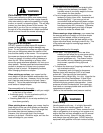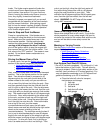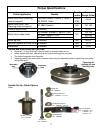
13
How to Test/Use the Blade Clutch/Brake
Switch
Before testing the blade clutch/brake operation,
make sure the area is clear and there is nothing
vulnerable to thrown objects from under the mower.
No one should be near the mower deck or in its line
of discharge. The discharge chute deflector should
be in the down position. The parking brake should
now be applied. Move the engine throttle to ¾
speed setting. When mowing, the engine speed
should always be at its highest setting. The engine
governor will regulate the engine according to the
different mowing conditions at that setting. Place
both feet firmly on the foot platform and turn on the
blade clutch switch. Run blades for a minute or so.
Try engaging and disengaging the blades a few
times about 10 seconds apart. If the blades do not
start and stop in 6-9 seconds each time, service the
blade brake system or contact your local Wright
dealer. Under mowing load, the clutch’s life will be
the greatest if engaged and disengaged at the ¾
throttle level.
How to Test the Operator Presence
Control (OPC) Switch
A three second time delay was added to eliminate
clutch cycling on bumpy terrain. To test, apply the
parking brake and turn ON the blades, try lifting
your feet off the foot platform to test the Operator
Presence Control switch (OPC). The engine should
kill and the blades should stop within 6-9 seconds.
If not, service the OPC system or contact your local
Wright dealer.
Service and Adjustments
Tire Maintenance and Pressure
Excessively worn tire tread is dangerous on all hills.
Replace drive tires with less than 3/32” of any tread
groove left. Use tires with the tread pattern
recommended by Wright Mfg., Inc. only. Keep the
tire pressure in the drive tires between 18 and 22
psi. Higher pressures will cause the tires to have
less traction, which will force you to go slower and
with less safety and give you a harder ride. Front
Casters are equipped with non-pneumatic tires and
do not required any air. They do not have any tread
but should be replaced when excessively worn.
Lowering the tire pressure below the recommended
pressure will change the pitch of the deck which
may require further deck pitch adjustment.
Height-of-Cut
Before Adjusting the Height-of-Cut be sure the
mower blades are not spinning, and both rear tires
have proper air pressure. Check for even tire wear.
The height-of-cut can be adjusted the following
ways:
• Pull the deck lift lever on the right hand side
of the mower towards the rear of the mower
until it clicks once into the locked transport
position. Then set the mower blade height
with the selector pin on the left hand side of
the mower. Once the proper height setting
is set on the left, pull back on the deck lift
lever on the right side and then lower the
lever towards the front of the machine until it
stops at the set height-of-cut.
Deck Adjustments
The mower deck can be adjusted for pitch and side-to-
side levels. Pitch is the relationship between the front
of the deck and the rear of the deck in regards to height
of cut. In most cases, a positive pitch (front of the deck
is lower than the rear of the deck) of ¼” is the optimum
setting. The adjustments can easily be made by using
the deck lift rod assemblies attached to the front and
rear deck lift arms and the threaded deck hangers (deck
pitch and side-to-side adjustments) located at the front
of the deck and at the rear of the deck frame. These
hangers are connected to the chains that hold the deck.
If you raise any of these settings above the factory
setting, the deck may not raise all the way up into the
transport position. Be sure and check the deck
First ensure Deck Lift Rod is 29” from center to center of
the ball ends
Fine
Adj
ustments
Pitch and side-to-side
Rear
Front


















